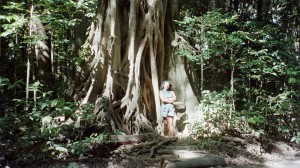
Yesterday, I talked about animal life in the region. Before we leave Cape Tribulation, I want to also discuss some unusual plant life. Notice that I’m standing in the photo to give a sense of relative size. The roots on this long-time local resident are even taller than I am. The Blue Quandon towers up to 35 yards high with a prominently buttressed base and distinctive blue fruit like large suspended figs.
Meanwhile the Stinging Tree is strictly a look-but-don’t-touch type of flora. The heart-shaped leaves have jagged edges but the real danger is the thousands of microscopic needles that embed themselves in the skin if touched. Heaven help the person who uses these leaves as a substitute for toilet paper. Unfortunately, it has been known to happen in rare instances and requires treatment at a hospital. My advise: wait and use the facilities at the next rest stop.
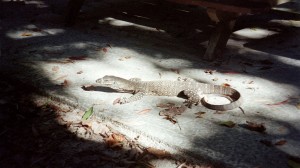 Speaking of which, at a rest area, I came upon a rather large lizard, sunning himself, on the sidewalk. I didn’t approach and attempt to stand next to him for a size comparison. He was well over 3 feet long from the tip of his nose to the tip of his tail. I didn’t want him to scurry off but he seemed completely unperturbed by the presence of people. I believe he owned the place and apparently, so did he.
Speaking of which, at a rest area, I came upon a rather large lizard, sunning himself, on the sidewalk. I didn’t approach and attempt to stand next to him for a size comparison. He was well over 3 feet long from the tip of his nose to the tip of his tail. I didn’t want him to scurry off but he seemed completely unperturbed by the presence of people. I believe he owned the place and apparently, so did he.
Also, when walking through the rainforest, be wary of the wait-a-while vines hanging down from trees to the ground or gathered in clumps around the base of a tree. These are covered with small spikes that grab at clothing and can tear skin. It’s best to stay with your guide or use areas that have boardwalks built into the area for visitors.
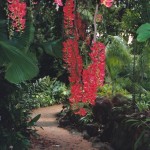 If you are an avid gardener, the Cairns Botanical Gardens may be just the kind of relaxed, cultivated and safe place to visit at your leisure after you return from this wildnerness. But it might all seem quite tame after our recent adventures.
If you are an avid gardener, the Cairns Botanical Gardens may be just the kind of relaxed, cultivated and safe place to visit at your leisure after you return from this wildnerness. But it might all seem quite tame after our recent adventures.
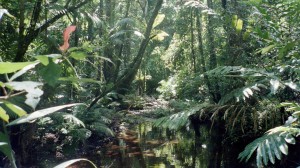 Traveling farther north of Cairns, you approach the Heritage-listed Daintree Rainforest, the oldest rainforest in the world, containing the most species of plants and animals in Australia. This is a lush, tropical but wild world best experienced with an expert guide. This is an unpredictable environment, not a petting zoo or a place to wander off and explore alone.
Traveling farther north of Cairns, you approach the Heritage-listed Daintree Rainforest, the oldest rainforest in the world, containing the most species of plants and animals in Australia. This is a lush, tropical but wild world best experienced with an expert guide. This is an unpredictable environment, not a petting zoo or a place to wander off and explore alone.
The indigenous cassowary, somewhat resembling an ostrich in size and appearance, is listed as an endangered species and is quite rare and elusive. Standing between 5 and 6 feet in height, it has a black body and bright blue head with 2 swinging wattles at the front of its neck and an orange patch at the back. This flightless bird has one very long, sharp spike on each foot. If it feels threatened, it has been known to charge straight ahead, lashing out violently with those claws and slashing the target to ribbons.
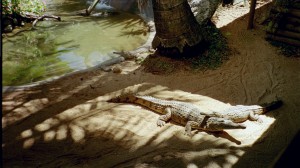 If you take a cruise on the Daintree River, you may spy an estuarine crocodile lazing on the riverbank. It’s the ones you don’t see lurking underneath the water that are truly dangerous. In one rapid movement, they will pounce with sudden fury on unsuspecting prey, wrestling with them before dragging them below the water line. This is as close as you want to get. Definitely no swimming here.
If you take a cruise on the Daintree River, you may spy an estuarine crocodile lazing on the riverbank. It’s the ones you don’t see lurking underneath the water that are truly dangerous. In one rapid movement, they will pounce with sudden fury on unsuspecting prey, wrestling with them before dragging them below the water line. This is as close as you want to get. Definitely no swimming here.
We will return to our 4WD vehicle and take the cable ferry across the Daintree River to continue our journey through the Cape Tribulation wilderness area. Later, we will visit the coast for an invigorating walk on Coconut Beach and some afternoon tea before heading back to “civilization”.
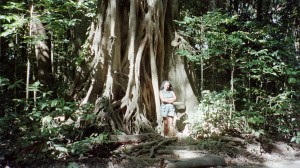 Yesterday, I talked about animal life in the region. Before we leave Cape Tribulation, I want to also discuss some unusual plant life. Notice that I’m standing in the photo to give a sense of relative size. The roots on this long-time local resident are even taller than I am. The Blue Quandon towers up to 35 yards high with a prominently buttressed base and distinctive blue fruit like large suspended figs.
Yesterday, I talked about animal life in the region. Before we leave Cape Tribulation, I want to also discuss some unusual plant life. Notice that I’m standing in the photo to give a sense of relative size. The roots on this long-time local resident are even taller than I am. The Blue Quandon towers up to 35 yards high with a prominently buttressed base and distinctive blue fruit like large suspended figs.
Meanwhile the Stinging Tree is strictly a look-but-don’t-touch type of flora. The heart-shaped leaves have jagged edges but the real danger is the thousands of microscopic needles that embed themselves in the skin if touched. Heaven help the person who uses these leaves as a substitute for toilet paper. Unfortunately, it has been known to happen in rare instances and requires treatment at a hospital. My advise: wait and use the facilities at the next rest stop.
 Speaking of which, at a rest area, I came upon a rather large lizard, sunning himself, on the sidewalk. I didn’t approach and attempt to stand next to him for a size comparison. He was well over 3 feet long from the tip of his nose to the tip of his tail. I didn’t want him to scurry off but he seemed completely unperturbed by the presence of people. I believe he owned the place and apparently, so did he.
Speaking of which, at a rest area, I came upon a rather large lizard, sunning himself, on the sidewalk. I didn’t approach and attempt to stand next to him for a size comparison. He was well over 3 feet long from the tip of his nose to the tip of his tail. I didn’t want him to scurry off but he seemed completely unperturbed by the presence of people. I believe he owned the place and apparently, so did he.
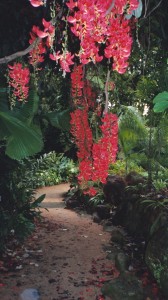
Cairns Botanic Gardens
Also, when walking through the rainforest, be wary of the wait-a-while vines hanging down from trees to the ground or gathered in clumps around the base of a tree. These are covered with small spikes that grab at clothing and can tear skin. It’s best to stay with your guide or use areas that have boardwalks built into the area for visitors.
If you are an avid gardener, the Cairns Botanical Gardens may be just the kind of relaxed, cultivated and safe place to visit at your leisure after you return from this wildnerness. But it might all seem quite tame after our recent adventures.
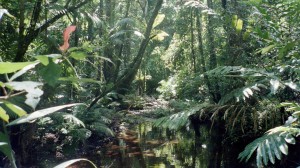 Traveling farther north of Cairns, you approach the Heritage-listed Daintree Rainforest, the oldest rainforest in the world, containing the most species of plants and animals in Australia. This is a lush, tropical but wild world best experienced with an expert guide. This is an unpredictable environment, not a petting zoo or a place to wander off and explore alone.
Traveling farther north of Cairns, you approach the Heritage-listed Daintree Rainforest, the oldest rainforest in the world, containing the most species of plants and animals in Australia. This is a lush, tropical but wild world best experienced with an expert guide. This is an unpredictable environment, not a petting zoo or a place to wander off and explore alone.
The indigenous cassowary, somewhat resembling an ostrich in size and appearance, is listed as an endangered species and is quite rare and elusive. Standing between 5 and 6 feet in height, it has a black body and bright blue head with 2 swinging wattles at the front of its neck and an orange patch at the back. This flightless bird has one very long, sharp spike on each foot. If it feels threatened, it has been known to charge straight ahead, lashing out violently with those claws and slashing the target to ribbons.
 If you take a cruise on the Daintree River, you may spy an estuarine crocodile lazing on the riverbank. It’s the ones you don’t see lurking underneath the water that are truly dangerous. In one rapid movement, they will pounce with sudden fury on unsuspecting prey, wrestling with them before dragging them below the water line. This is as close as you want to get. Definitely no swimming here.
If you take a cruise on the Daintree River, you may spy an estuarine crocodile lazing on the riverbank. It’s the ones you don’t see lurking underneath the water that are truly dangerous. In one rapid movement, they will pounce with sudden fury on unsuspecting prey, wrestling with them before dragging them below the water line. This is as close as you want to get. Definitely no swimming here.
We will return to our 4WD vehicle and take the cable ferry across the Daintree River to continue our journey through the Cape Tribulation wilderness area. Later, we will visit the coast for an invigorating walk on Coconut Beach and some afternoon tea before heading back to “civilization”.

 Speaking of which, at a rest area, I came upon a rather large lizard, sunning himself, on the sidewalk. I didn’t approach and attempt to stand next to him for a size comparison. He was well over 3 feet long from the tip of his nose to the tip of his tail. I didn’t want him to scurry off but he seemed completely unperturbed by the presence of people. I believe he owned the place and apparently, so did he.
Speaking of which, at a rest area, I came upon a rather large lizard, sunning himself, on the sidewalk. I didn’t approach and attempt to stand next to him for a size comparison. He was well over 3 feet long from the tip of his nose to the tip of his tail. I didn’t want him to scurry off but he seemed completely unperturbed by the presence of people. I believe he owned the place and apparently, so did he. If you are an avid gardener, the Cairns Botanical Gardens may be just the kind of relaxed, cultivated and safe place to visit at your leisure after you return from this wildnerness. But it might all seem quite tame after our recent adventures.
If you are an avid gardener, the Cairns Botanical Gardens may be just the kind of relaxed, cultivated and safe place to visit at your leisure after you return from this wildnerness. But it might all seem quite tame after our recent adventures.




